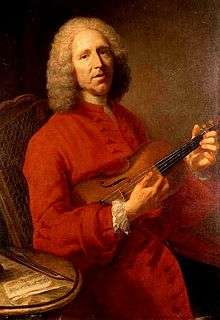Pigmalion (opera)
| Jean-Philippe Rameau |
|---|
 |
|
Operas
See also: |
For the opera by Georg Benda see Pygmalion (opera)
Pigmalion is an opera in the form of a one-act acte de ballet by Jean-Philippe Rameau first performed on 27 August 1748 at the Opéra in Paris. The libretto is by Ballot de Sauvot. The work has generally been regarded as the best of Rameau's one-act pieces. He was said to have composed the work in eight days.
Roles
| Role | Voice type | Premiere Cast, 27 August 1748 [1] (Conductor: - ) |
|---|---|---|
| Pigmalion (Pygmalion) | haute-contre | Pierre Jélyotte[2] |
| L'Amour (Cupid) | soprano | Marie-Angélique Coupé |
| Céphise | soprano | Mlle Rotisset de Romainville |
| La statue animée (The animate statue) | ballerina and soprano | Mlle Puvignée fille |
Synopsis

The story is based on the myth of Pygmalion as told in Ovid's Metamorphoses. In Rameau and de Sovot's version, the sculptor Pigmalion creates a beautiful statue to which he declares his love. His girlfriend, Céphise, begs for attention; Pigmalion spurns her and entreats the goddess Venus to bring his statue to life. Magically the statue enlivens, sings, and dances; Cupid arrives and praises Pigmalion for his artistry and faith in his powers. Much celebratory dancing and singing follows, attesting to the power of love. Cupid helpfully finds another lover for Céphise.
Recordings
- Pygmalion Orchestre de chambre des Concerts Lamoureux, Marcel Couraud (Archiv Produktion, recorded 1962)
- Pigmalion La Petite Bande, Sigiswald Kuijken (Deutsche Harmonia Mundi, 1981)
- Pigmalion English Bach Festival Singers and Orchestra, Nicholas McGegan (Erato, 1984)
- Pigmalion Les Arts Florissants, William Christie (Harmonia Mundi, 1992)
- Pygmalion Concert Royal, James Richman (Centaur, 2010)
References
- Notes
- ↑ According to Lajarte, p. 207.
- ↑ Although he lists all the minor performers, Lajarte omits reporting the name of the interpreter of the title role. It is stated instead by Arthur Pougin in his Un ténor de l'Opéra au XVIIIe siècle - Pierre Jélyotte et les chanteurs de son temps, Paris, Fischbacher, 1905, p. 172 (copy at Internet Archive).
- Sources
- Girdlestone, Cuthbert, Jean-Philippe Rameau: His Life and Work, New York: Dover, 1969 (paperback edition)
- Holden, Amanda (Ed.), The New Penguin Opera Guide, New York: Penguin Putnam, 2001. ISBN 0-14-029312-4
- (French) Lajarte, Théodore Bibliothèque Musicale du Théatre de l'Opéra. Catalogue Historique, Chronologique, Anecdotique, Tome 1, Paris, Librairie des bibliophiles, 1878 (copy at Internet Archive)
- Sadler, Graham, ed., The New Grove French Baroque Masters Grove/Macmillan, 1988
- Lambert, Kevin, "Hearing Pygmalion’s Kiss: A Scientific Object at the Paris Opéra", Physics in Perspective 16, no. 4 (2014): 417–439. DOI: 10.1007/s00016-014-0148-2.